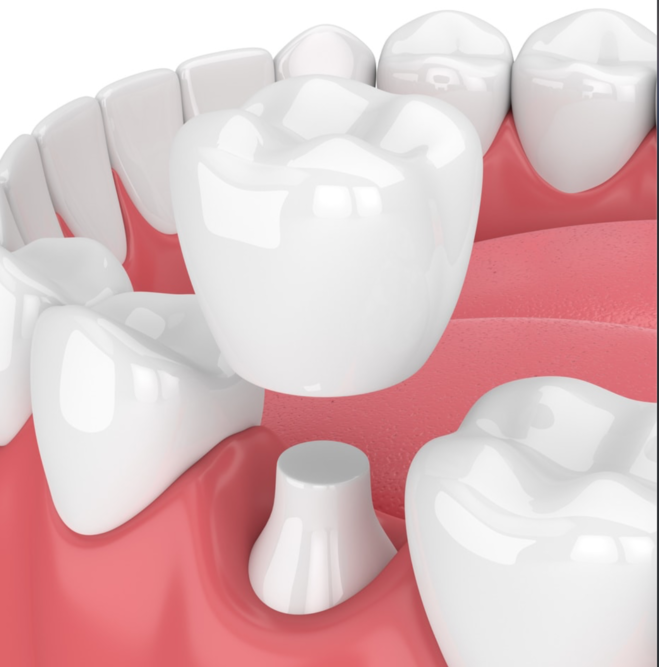Crown
Bridge
If several teeth are damaged or may be missing, they will either be replaced by a series of crowns or by a bridge. The bridge is a tooth construction whose “pillars” represent the neighboring teeth.
If the damage to a tooth goes to such an extent that there is no possibility of making a possible crown, but the root is still healthy, then you must strengthen the tooth with a pin so that the crown can be placed on top.
Crowns, bridges
- To replace large fillings when the tooth material is insufficient for a new filling
- To protect weak teeth from demolition
- To make broken teeth complete again
- To form a bridge link
- To fix on implants
- To cover discolored, low-form teeth
- To cover teeth that had already had a root canal treatment
Materials for crowns and bridges
FULL METAL CERAMIC CROWN
The denture consists for the majority of a metal framework, which consists of precious metal (gold) or non-precious metal. The porcelain veneer comes on top of this metal framework – produced in the color that best suits the needs of the patient, so that the dentures harmonize with the color of the teeth in the mouth.
METALLFREIE KRONEN
In the field of completely aesthetic, flawless dentures you have to highlight the metal-free dentures. Advantages of metal-free crowns and bridges are that they are 100% metal-free and biocompatible. This type of tooth replacement allows a high accuracy of fitting. An increasingly important role is played by the all-ceramic or zirconium oxide crowns.
In this case, the impression made by the dentist after tooth preparation is recorded with the scanner. Based on the data, a computer-controlled device makes the framework, and the dental technician then makes the veneering. This procedure guarantees perfect aesthetics and high precision.
CIRCON CROWN, PORCELAIN CROWN, METAL CERAMIC CROWN - WHAT SHOULD I CHOOSE?
Dental crowns made entirely of porcelain do not contain an internal framework, so they are much more vulnerable than crowns with a zirconium framework. Metal-ceramic crowns build on an inner metal framework,thus their light transparency decreases, also may gray over time the edges of the teeth. Circonia crowns have a circonium framework in the shade of the teeth on which veneering porcelain can be obtained, thus enabling the production of durable, solid and esthetic dentures.
FULL CERAMIC CROWN
A full ceramic crown guarantees a maximum of aesthetics compared to your own tooth. This porcelain crown is hardly distinguishable from a natural tooth. The light transmission from the pressed ceramic crowns is excellent.
The possible applications are quite manageable due to the slightly more limited breaking strength: single crowns, veneers – not for crunchers, small bridges in the front area.
Advantages of dentures made of pressed ceramics:
- Biocompatibility, excellent light transmission
- The risk of spalling of small ceramic parts is minimal
CIRCON CROWN
There are not only functional but also aesthetic reasons for replacing our lost teeth. In addition to metal-ceramic crowns, dental technicians have always searched for materials that look as natural as possible, and in addition to their strength and durability, they also have high light transmittance.
In modern dental treatment, the use of circonium materials – which have high strength – has become possible through the advance of CAD / CAM technology.
Advantage of denture made of circonia oxid:
Metal free, thus it won’t trigger an allergic reaction, thanks to the CAD/CAM technology it fits exactly on the tooth or on the implant head, also suitable for bridging tooth gaps.




